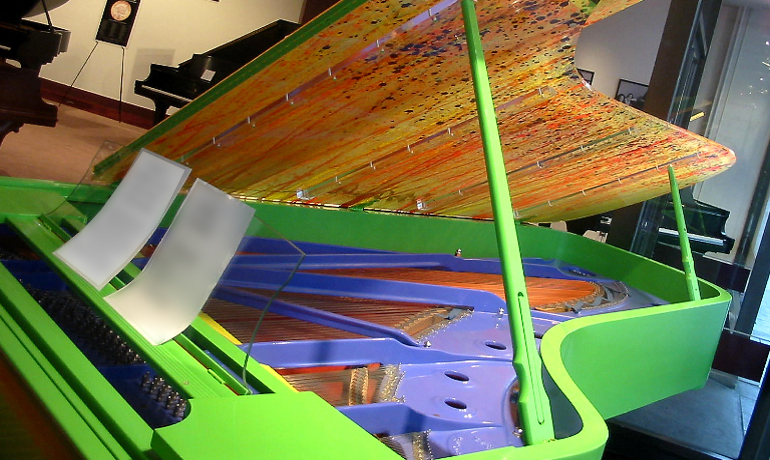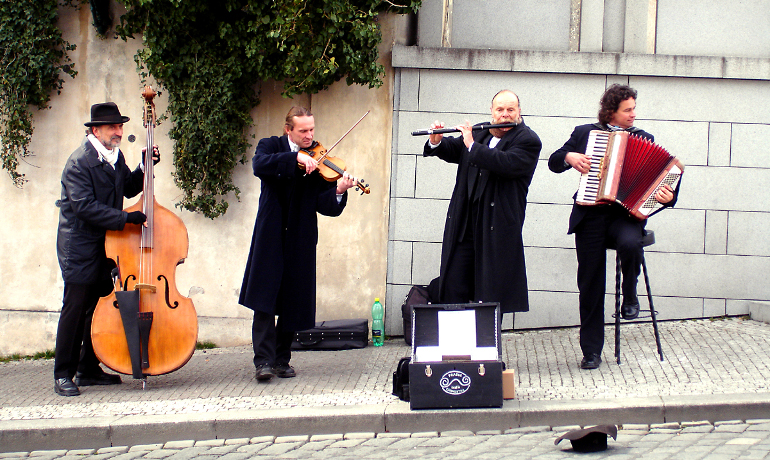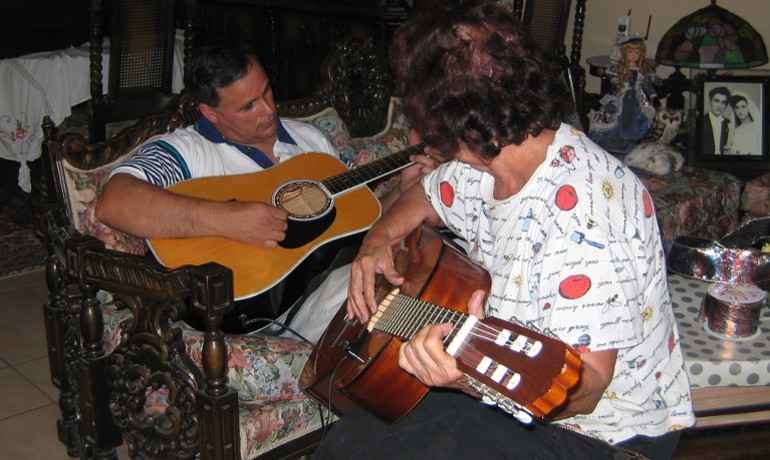MUSIC & LANGUAGE
Music and language work hand in hand throughout out the world. Music is appreciated and understood, in different ways, by almost everyone, from the fetus listening to the rhythm of her mother's heartbeat and hearing the rising and falling tones of her voice, to the ancient on his deathbed humming a tune from his youth. Language development starts with musical elements such as an infant's rhythmic movement, crying, and babbling, then proceeds to linguistic elements, like consonants, words, and phrases, and eventually to speaking with perfect accent. In this way, music is the beginning of language, but it is also the end of language, because musical aspects such as timing, speed, and intonation of phrases, length of pauses, and stress of syllables are required for clarity of meaning.
Grammar helps to make the meaning of a sentence clear. For instance, we don't say "He go to the store." Person, a type of grammatical agreement, dictates that we say, "He goes." Case, another type of grammar agreement, changes the ending of words, based on their roles in the sentence. In English, the ending -'s is a possessive case marker. When we want to make the subject pronoun "he" into the receiver of an action, we use the object word "him," which is the dative case form of "he." While English mainly uses word order to determine sentence roles, other languages, like Latin, use case to indicate grammar roles. In these languages, an adult learner has to not only learn vocabulary, but also the case-based ways in which the words change form, or morphology. Learners have to think of words in terms of their grammar role in the sentence, and change the word endings, or inflections appropriately.
Czech Language Example
Making the words in a foreign language agree is a difficult task, but music can help. To demonstrate this, I've chosen to the Czech language, a case-based, Slavic language spoken by ten million people in the Czech Republic. I began to learn Czech in 1993, having had some limited success learning Russian. The Czech language uses seven different cases. Students learn vocabulary in subject case, then learn different forms in various phrase contexts. The words for "tree" in the seven different cases are: 1. strom 2. stroma 3. stromu 4. strom 5. strome 6. stromu 7. stromem.
To demonstrate the five different case endings, I put together several "root phrases," as shown in the chart below. The subject case Czech words for "that" in feminine and masculine gender are "ta" and "to". We'll leave out the fifth case for now, so that leaves five more cases - 2, 3, 4, 6, and 7. For instance, if want to say "to that," we take "k" + "tomu" and get the phrase k tomu. These phrases are models that a learner can use to compare and generate proper endings for new words.
|
|
|
that (m) |
that (f) |
|
|
|
to |
ta |
|
to |
K |
tomu |
te |
|
with |
S |
tim |
tou |
|
about |
O |
tom |
te |
|
for |
Pro |
toho |
tu |
|
without |
Bez |
toho |
te |
The beauty of this system is that, in addition to the pronouns here, adjectives,
some nouns, and many other pronouns follow the same grammar patterns.
These ten simple phrases indicate how other words would change in these cases.
This principle is known as "inflectional harmony."
For example, the phrase "towards that beautiful castle" - "k tomu krasnemu hradu"
has a /mu/ ending in common, which repeats in all other hard adjectives that
would appear in this type of phrase. These associations are crucial for good
intuitions about grammaticality. So I wrote a song that teaches the phrases.
When the students know the song by heart, they can begin adding other words to the end of the mini-phrases to make complete prepositional phrases. The mnemonic allows any combination of words up to eight syllables. The music serves as a recall device for the unfamiliar phrases.
This musical method is a natural extension of grammar drills that actually makes them fun and worthwhile. In this case, rhythm and music improves the memorability of phrases in a way that simple repetition cannot. This is an effective method, and I've used it with several Czech language beginners. In the end, Language fluency is about automaticity. Just because someone knows the right answer after thinking about it, it doesn't mean that person can speak in a conversation. The language needs to be acquired at the level of automatic behavior, through repetition. The extension of short phrases with new words encourages creative hypothesis-building, which is a another key element to language learning. When learning strategies are combined in this way, multiple intelligences are activated, and the learning environment seems rich and real. Related intelligences, such as movement, vision, musicality, and language, seem to work best together.
I have often turned towards rhythm and music for help in my life and learning, generally, so I should explain that the Ktomu Song came from a flash of insight or realization. I was consciously searching for patterns in the prepositional phrases, and I remembered a World Music class I took that featured Ghanan drum music. The text took on a life of its own, and generated a rhythm. Because of my music training, the intonations suggested notes, and the notes fell into chords, which became lines of music, and finished into a full song. In this way, active, musical, participatory elements came into my own practice of language learning.



